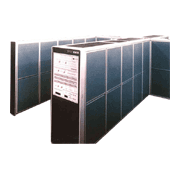These were high-end machines in the HITAC-8000 Series of general-purpose machines. The HITAC 8700 was announced in 1970, and the HITAC 8800 in the following year.
In 1967, a national project to develop ultra high-performance electronic computers was initiated, and Hitachi was asked to play the central role. This project brought together the best of Japanese domestic technology, and the machine had a scientific mix (Gibson mix) time of 200 or 300ns, which was the fastest for a domestic machine at that time, so performance was at the top level in the world. Academia, government and industry provided support and cooperation, and related parties gave their best effort, and the machine was completed after 6 years in August 1972. The HITAC 8800/8700 was developed commercially by improving performance and using the technological results of this project, such as: (1) Japan's first domestically produced 32-bit virtual addressing system, (2) Multi-processors sharing main memory and a buffer memory system, (3) A single LSI for doing the work of 10 ICs, (4) High-density mounting technology, and (5) A pipeline control system.
As the top-end machine in the HITAC 8000 Series, the HITAC 8800 was used for various types of scientific and engineering computation in facilities like large computing centers at universities, and national research institutes. As a large machine one step below the HITAC 8800, the HITAC 8700 was used for a wide-range of applications, in large-scale online systems and high-volume batch processing, and in time-sharing systems used simultaneously by many users.



